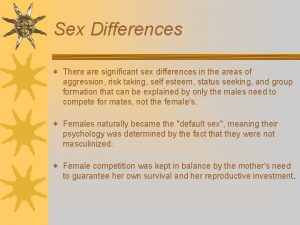Actual Gender Differences There are documented gender differences




































- Slides: 36

Actual Gender Differences • There are documented gender differences – Exs: aggression, activity level, compliance, emotional expressivity

But: • Relatively few documented differences – Gender stereotypes suggest more differences than are actually documented by research • Even documented differences are relatively small in size – Average performance of males and females is not extremely different

Figure 15. 3 A typical distribution of scores Siegler, De. Loache and Eisenberg: How Children Develop, Second Edition Copyright © 2006 by Worth Publishers

Gender Typing • Process by which a child: – Becomes aware of his or her gender and that of other people – Acquires information about the characteristics and behavior viewed as appropriate for males or females (gender stereotypes) – Acquires the characteristics and behaviors viewed as appropriate for either males or females (gender roles)

Development of Gender Awareness • By 2. 5 to 3 years, children label their own sex and that of other people • Do not yet understand that sex is a permanent characteristic

Development of Gender Stereotypes • By 2. 5 years, children have some knowledge of gender stereotypes • Over the preschool/early school years, learn more about toys, activities, and achievement domains considered appropriate for boys versus girls – Ex (achievement): boys are good at math; girls are good at English

• Preschoolers’ gender stereotypes tend to be rigid – Don’t usually realize that characteristics associated with sex (e. g. , activities, clothing) don’t determine whether one is male or female • May be one reason they treat gender stereotypes as “rules” rather than as beliefs

• By elementary school, children’s gender stereotypes are more flexible – Understand that stereotypes are beliefs, not “rules” – However, older children do not necessarily approve of “cross-gender” behavior

Development of Gender Role Behavior • Between approximately 14 -22 months, children begin to show sex-typed toy preferences • Sex-typed toy play increases through the preschool years • Children begin to avoid peers who violate gender roles

• Gender segregation develops by ages 2 to 3 years – Tendency to associate with same-sex playmates • Typically lasts until around the onset of puberty

Biological Influences on Gender Typing (Hormonal Influences) • Experimental animal studies indicate that exposure to androgens (male sex hormones): – Increases active play in male and female mammals – Promotes male-typical sexual behavior and aggression and suppresses maternal caregiving behavior in a wide variety of species

Humans: • Cannot do experimental research for ethical reasons – Correlational research

• In boys, naturally occurring variations in androgen levels are positively correlated with – Amount of rough-and-tumble play – Levels of physical aggression

• Congenital Adrenal Hyperplasia (CAH) – Disorder in which child is exposed to high levels of androgens from the prenatal period onward – Compared to girls without CAH, girls with CAH show • Higher activity levels • Greater interest in “male-typical” toys, activities, and occupations • Better spatial/mathematical abilities

Environmental Influences on Gender Typing • Social Learning Theory – Gender typing results from • Observational learning – By watching male and female “models”, children learn “appropriate” appearance, activities/occupations, and behavior for each sex • Rewards and punishments associated with gendertyped behavior – Rewards for conforming to appropriate gender role and lack of rewards and/or punishment for failure to conform

Parental Behavior • On average, data suggest that differences in parental treatment of boys and girls are not large • Does not mean that parental behavior is unimportant because: – Younger children receive more direct “training” from parents about gender roles than do older children – Parents vary in the extent to which they practice differential treatment

Evidence for Differential Treatment • Some data indicate that parents – Provide gender-stereotyped toys (e. g. , vehicles, dolls) – Are more responsive when children engage in “gender-appropriate” play • But data are not always consistent across studies – Parents also provide gender-neutral toys for children

• Gender-stereotyped toys may encourage different behaviors, characteristics, or abilities in males and females – Parents give toys that encourage action and competition to boys (e. g. , toy weapons, toy vehicles, construction toys and tools, sports equipment) – Parents give toys that encourage nurturance, cooperation, and physical attractiveness to girls (e. g. , dolls/stuffed animals, toy dishes, jewelry, jump ropes)

• Other evidence indicates that parents encourage different behaviors in boys and girls – More likely to encourage independence in boys • Respond more positively when boys demand attention, are highly active, or try to take toys from others • Also more likely to – Refuse or ignore a son’s request for help – Challenge boys in teaching situations (e. g. , offer scientific explanations, ask high-level questions)

– More likely to encourage closeness and dependence in girls • More likely to: – Direct play activities – Provide help – Engage in conversations – Talk about emotions

• Differential treatment of boys and girls may be relatively subtle – Data indicate gender differences in parentchild communication • Parents more likely to offer scientific explanations to sons than to daughters (at a museum) – Ex: “When you turn that fast, it makes more electricity” versus “Turn that handle”

Pasterski et al. (2005) • Comparison of toy choices in girls and boys with CAH and their siblings (without CAH) – Girls with CAH played with “boys’ toys” more and “girls’ toys” less than their unaffected sisters – No differences between boys with CAH and their unaffected brothers

• Parental Behavior – Parents gave more negative responses to their unaffected sons than to their unaffected daughters for play with “girls’ toys” – Parents gave more positive responses to daughters with CAH than to unaffected daughters for play with “girls’ toys”

• Parental Behavior and Children’s Toy Choices – For unaffected children, parents’ positive and negative responses to children’s toy choices were related to children’s play behavior • Positive responses to children’s play with certain toys related to more play with those toys (and vice versa for negative responses) – For children with CAH, parental behavior was not related to children’s toy choices

Peer Behavior • By age 3, children reinforce each other for “gender-appropriate” play (e. g. , by praising, imitating, or joining in) • Criticize children who engage in “crossgender” activities – Boys are especially critical of other boys

• Male and female peer groups may promote different styles of interaction – Boys more often rely on commands, threats, and physical force – Girls use polite requests, persuasion— works with girls but not with boys

• Cognitive theories emphasize children’s active role in the process of gender typing (self-socialization)

Cognitive Developmental Theory (Kohlberg) • Three Stages: – Basic Gender Identity: • Recognition that one is a boy or a girl – Emerges between 2. 5 and 3 years

– Gender Stability • Understanding that gender is stable over time – Emerges between 3 and 5 years

– Gender Constancy/Consistency • Understanding that gender is constant/consistent across situations regardless of appearance or activities – Emerges between 5 and 7 years

• Kohlberg: Gender constancy leads to adoption of gender roles – Why is this incorrect?

Gender Schema Theory: • Children construct gender schemas – Organized mental representations incorporating information about gender • Include children’s own experiences and information conveyed by others, including gender stereotypes • Schemas are dynamic—change as children acquire additional information

• Once children achieve basic gender identity, they are motivated to conform to gender roles • Motivated to prefer, pay attention to, and remember more about others of their own sex • Children use gender schemas to process information and guide their behavior


Gender Schema Theory: Evidence Martin et al. (1995) Study 3: – Children used gender labels given to toys to guide their behavior • Ex: If a toy was labeled as a “boy” toy, girls reported that they were less interested in it and that other girls would also be less interested in it than if the toy was labeled as a “girl” toy (and vice versa for boys) – True even if the toy was very attractive

• Children also show biases in their memory for information about gender – More likely to accurately remember information that is consistent with gender stereotypes – More likely to forget or distort information that is inconsistent with gender stereotypes
 Insidan region jh
Insidan region jh Response blocking vs extinction
Response blocking vs extinction Before the statue of liberty toefl
Before the statue of liberty toefl Racism in huckleberry finn essay
Racism in huckleberry finn essay Difference between actual yield and theoretical yield
Difference between actual yield and theoretical yield Sanctifying grace and actual grace
Sanctifying grace and actual grace Strategic gender needs and practical gender needs
Strategic gender needs and practical gender needs Is there any bias in gender roles based on the excerpt
Is there any bias in gender roles based on the excerpt The tweezers in this drawer
The tweezers in this drawer There was there were ile ilgili cümleler
There was there were ile ilgili cümleler There are there is
There are there is Sightseeing countable or uncountable
Sightseeing countable or uncountable правило a an some any
правило a an some any There is there are ejemplos
There is there are ejemplos There is there are exercises
There is there are exercises There isn't a burger
There isn't a burger Ecological succession
Ecological succession Mushrooms contable o incontable
Mushrooms contable o incontable What part of speech is open
What part of speech is open There is there are
There is there are There is there are
There is there are There is and there
There is and there There is there are negative form
There is there are negative form There
There Demonstrativos
Demonstrativos How to draw texture
How to draw texture Stimulated texture in art
Stimulated texture in art Actual parameters in c
Actual parameters in c Which memory is the actual working memory?
Which memory is the actual working memory? Realidad actual
Realidad actual Sistema periódico actual
Sistema periódico actual Theoretical yeild
Theoretical yeild Actual cost method
Actual cost method Criterion deficiency and contamination
Criterion deficiency and contamination Cost of food sold formula
Cost of food sold formula Actual work done
Actual work done The actual surface feel of the simulated appearance
The actual surface feel of the simulated appearance



























































